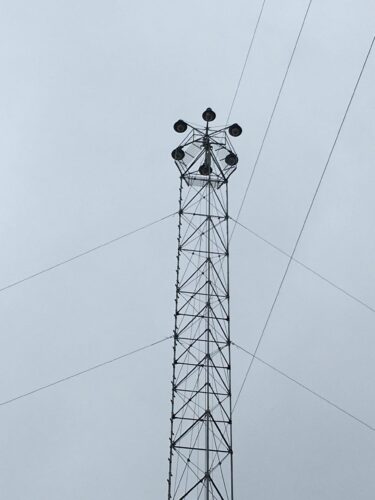
If you Google “America’s first serial killer” H. H. Holmes pops up. Mental Floss wrote an article listing nine things we didn’t know about America’s first serial killer. There’s a documentary called H. H. Holmes: America’s First Serial Killer, which you can watch on Amazon Prime. Even tour companies in Chicago that take people to the site where his Murder Castle once stood call him the first.
But if you read the fine print on sites like Biography, you’ll see H. H. Holmes wasn’t America’s first serial killer –he was one of the first.
That’s a minor but important distinction.
So then why do people give H. H. Holmes the title of being the first?
I’ll save you the suspense. I don’t actually know. (If you do, feel free to Check-In below and educate me.)
But I do know ever since I learned of H. H. Holmes, I’ve often talked about him as being America’s first serial killer too. So I’m just as guilty.
However, on a jaunt to Austin at the beginning of this year I learned about another serial killer. One who came before H. H. Holmes and even Jack the Ripper.
Here’s how the revelation happened.
The Moonlight Towers

Before the trip to Austin I did what I always do: consulted Atlas Obscura. They listed 30 weird and unusual things to do in Austin.
One of them was checking out the Moonlight Towers.
At first glance that might not have interested me, but it sounded sort of romantic. Was it something you did at night? Were they lights powered by the moon? I had to check it out.
Nope. None of those things.
Here’s the tagline Atlas Obscura has for the Moonlight Towers entry:
Turning night into day in Victorian-era Austin to thwart a serial killer.
Of course this macabre true crime connection instantly intrigued me.
According to Atlas Obscura, the towers were purchased for the city of Austin because of a grisly murder spree that happened there between 1884 and 1885.
The Servant Girl Annihilator / Austin Axe Murderer
The first murder happened on December 30, 1884. The victim was 25-year-old Mollie Smith. A man was also injured then, Walter Spencer.
The last victims were Susan Hancock and Eula Phillips on December 24, 1885. Eula’s husband was also wounded then.
Between these two dates, nine others would be either seriously injured or murdered.
Then, as suddenly as they had started, the attacks stopped.
Eight victims in all lost their lives: five black women, two white women, and one black man.
There were suspects galore (400 men were arrested), but the killer was never found. One man, James Philips, the husband of Eula Phillips (one of the last victims) was convicted of his wife’s murder but was later released when his sentence was overturned.
After the Christmas Eve attacks, people demanded more patrols and the installation of electric “Moonlight Towers” like ones Detroit used at that time. It was thought it would be harder for the murderer to ply his trade in the dead of light with these lights illuminating the city.
However, the towers weren’t installed until 1894, long after the last murder had happened.
But 1894 is when another serial killer struck…just not in Austin.
A Jack the Ripper Connection?
One of the most popular, but still unidentified, serial killers in history was London’s Jack the Ripper. Austin’s serial killer was a sensational story at the time but for whatever reason it didn’t stay that way.
People who don’t even like true crime have heard about Jack the Ripper, but that’s not true for the Servant Girl Annihilator.
Heck, even when using the less sensational “Austin Axe Murderer” name, most people don’t know Austin had such an incident.
But what’s interesting is that Austin’s killer may have a Jack the Ripper connection. Maybe.
Wikipedia details how there was a Malaysian man named Maurice who worked at a hotel in Austin in 1885. The killings stopped after he left Austin, which was in 1885.
In 1888, a sailor informed police about a Malay cook he knew that had said he’d been robbed by a Whitechapel woman. The cook vowed to “murder and mutilate every Whitechapel woman he met” until he found the one who’d robbed him and he got his money back.
The Austin victims also shared similarities with Jack the Ripper’s victims:
- The ones who died had not only been murdered but mutilated.
- All were also lower-class.
- Like the Whitechapel victims, the Austin victims lived within the same vicinity, only two or three blocks apart.
- Both murders suddenly stopped.
But Austin’s murders happened first.
The Timeline
- The Austin Servant Girl Annihilator murders happened between 1884-1885.
- Jack the Ripper struck in 1888.
- H. H. Holmes didn’t start killing in connection with his Murder Castle and Chicago’s 1893 Columbian Exposition until 1894 –or about the time Austin finally installed it’s Moonlight Towers.
So, nope. H. H. Holmes wasn’t America’s first serial killer, but he often mistakenly gets credited with the title.
Courtney Mroch is a globe-trotting restless spirit who’s both possessed by wanderlust and the spirit of adventure, and obsessed with true crime, horror, the paranormal, and weird days. Perhaps it has something to do with her genes? She is related to occult royalty, after all. Marie Laveau, the famous Voodoo practitioner of New Orleans, is one of her ancestors. (Yes, really! As explained here.) That could also explain her infatuation with skeletons.
Speaking of mystical, to learn how Courtney channeled her battle with cancer to conjure up this site, check out HJ’s Origin Story.

That’s fascinating. I didn’t know about the Austin SGA, how sad.